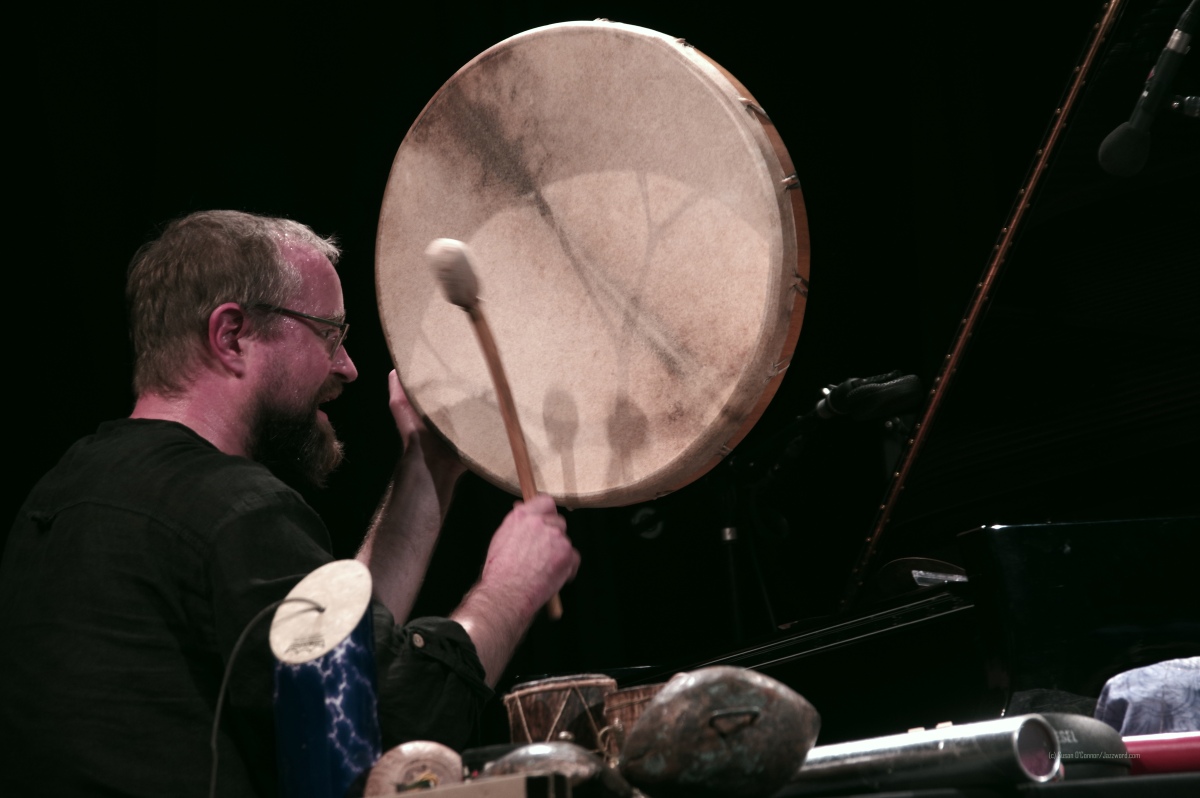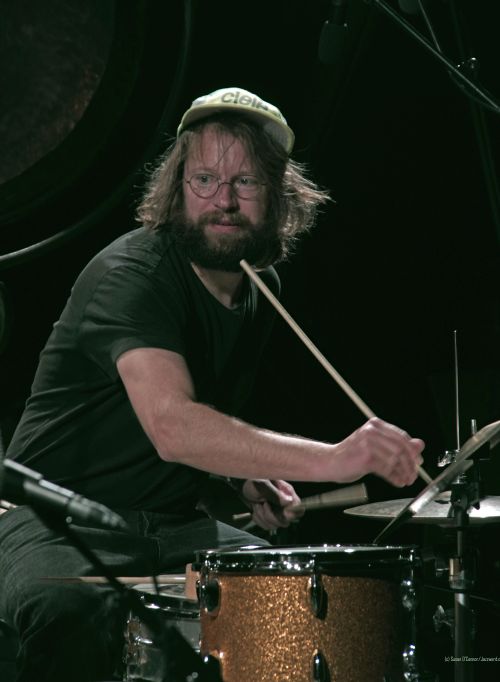
November 13-14: naTo Cultural Centre
Leipzig, Germany
By Ken Waxman Photos by Susan O’Connor
Designed to give improvised music a higher profile in the area, the annual Euphorium Festival takes place in Leipzig, an industrial city of 600,000 in the heart of former East Germany, some 200 kilometres from Berlin. Organized by local Oliver Schwerdt, the pianist, producer, writer and chief of the Euphorium record label, this year’s two evenings of mixed and matched programs in mid-November in the gritty naTo cultural centre in the city’s south end, featured committed improvisers of varied ages and experiences for unparalleled results.
In spite of Covid-19 restrictions, Euphorium 2021 had provocative performances that expanded on the distinctive skills of all participants. On hand were two veteran innovators, German percussionist Günter Baby Sommer and British bassist Barry Guy. Mid-career experimenters Swiss drummer Julian Sartorius, German trumpeter Axel Dörner, Mexican vibraphonist Emilio Gordoa and American trumpeter Liz Allbee were part of other configurations. Meanwhile, lesser-known German-based improvisers flutist Karoline Schulz, harpist Kathrin Pechlof and organist Daniel Beilschmidt contributed new ideas in larger groupings with Allbee and Gordoa. Schwerdt expressed himself on both nights playing piano plus a collection of little instruments that were blown into, thrown, slapped, tapped or shaken. There was also space for pseudo-Dadaist spoken word interjections from local Fredrich Kettilitz with Schwerdt’s enthusiastic accompaniment on Night 1, and an interlude of a short Guy composition for solo violin played by Switzerland’s Maya Homburger on Night 2.



Oliver Schwerdt; Daniel Beilschmidt & Karoline Schulz; Liz Allbee
With most of the younger players on stage the first night and with different artists in the foreground, improvisations were short. First-time meetings for many, the idea was to create duos, trios or larger units to react to particular concepts derived from individuals’ ideas, with each player adding stimulus. Schwerdt’s piano for instance, vibrated and clanged with items placed on the instrument’s internal strings to contrast with Pechlof’s more formal buzzing glissandi. At another point it was Beilschmidt’s smeared oscillations which provided a steadying ostinato for Schulz’s bass flute interpolations and Albee’s hand-muted brass bellows until the organist created a new theme based around kinetic pulses. At one point, Allbee inserted an elongated plastic tube between mouthpiece and lead pipe for maximum timbral flexibility and reactive tones.
Gordoa was often a show on his own. Situated on one side of the stage and boxed in by his vibraphone, gran casa and additional percussion, his strategy was melodic as well as rhythmic. Stroking his instrument’s metal bars with mallets to augment tones, he also rubbed a violin bow vertically among them for harsher interface. During the upsurge in sound and intensity on another improvisation, Beilschmidt bounced like a jack-in-the-box, creating fluid dual-keyboard enhancements while Gordoa reacted by smacking wooden blocks and resonating stentorian rumbles from the large, horizontal gran casa. Later he rubbed the vibes’ metal bars for maximum effect as Allbee sucked multiple tones through her horn, and Schulz’s bass flute snorts blared.


Emilio Gordoa, Kathrin Pechlof
The climactic finale set up more opaque, dissonant and ricocheting timbres from keyboard and percussion instruments. After Schwerdt slapped frame-drum patterns, shook maracas and cranked out gearwheel ratcheting, he first added slide-whistle trills then fluid two-handed keyboard kinetics. Meanwhile, Gordoa interrupted his cushioning vibe resonations to angle his head down and shout onto and between the vibes’ bars. At the same time, Allbee’s plastic tubing allowed her to project duck-like quacks, nasal growls and finally force unaccented air into the proceedings. Schulz’s low-pitched flute puffs maintained the improvisation’s linear flow until the end.


Baby Sommer, Barry Guy
Slightly more formal, Night 2 was divided into three sets. The first featured a trio of Schwerdt, Sartorius and Dörner; the second a solo Dörner faux-trumpet concerto, concluding with Guy and Sommer combining years of improvised smarts into a single challenging face-off backed by Schwerdt.
Beginning with solo ruminations on keyboard, Schwerdt’s sound evolution moved through an avant version of stride piano to dynamic Fire Music-like elbow and forearm keyboard pressures. The pianist was then joined by Sartorius’ drumming, which despite echoing clanks and clatters was often less percussive than Schwerdt’s idiophone-like keyboard clusters. As the pressure mounted, the duo mixture headed towards maximum intensity as Dörner’s stout brass blasts and slide-trumpet variations made their presence felt. Despite mute-application, murkiness remained in the melded sound that was only pierced when the trumpeter fired split tones at the top of his range. Kept on a horizontal path by Sartorius’ rhythmic cymbal lacerations as well as melodic hints from the pianist, this exposition downshifted when the others left the stage and Dörner played on a capella. Testing the limits of his instrument with a variation of circular breathing, he moved from shaky whines to spurts of raw and chilled air pockets, finally attaining continuous circulation before dissolving into silence.
In the subsequent set, Guy used only a bow and a couple of wooden sticks on his bass strings, Schwerdt a piano and his collection of little instruments, while Sommer put on a most theatrical and dazzling performance. Augmenting his standard drum kit was a set of mounted cymbals, a huge gong, several bell trees and vertical chimes.

Splayed on the stage were a marimba and xylophone Sommer knelt to play. Moreover, the percussionist sounded an alp horn or blew into a harmonica to add dissonant cries at appropriate junctures. All this, plus a collection of pots, pans and cutlery. Digging into the roots of Energy Music, Schwerdt kinetically slashed and stabbed the piano keys repeatedly, while Guy athletically rappelled up and down the bass strings and squeaked spiccato timbres with thrusts below the bridge as often as he conventionally addressed the tapered strings. Cannily the bassist also overcame disruptive interruptions from the others, which included the pianist suddenly smacking a large metal plate or slinging objects onto the piano strings, as well as the percussionist unexpectedly cranking up a police siren, blowing strangled melodies through his alp horn, or abruptly rattling a military march on his snare. Still, the dazzling visual climax of the set came when Sommer noisily up-ended his collection of pots, pans and kitchen utensils onto the stage, creating a unique cacophonic provocation which the bassist and pianist accepted. Maintaining rhythmic balance, they propelled the narrative forward even as musical shenanigans threatened to disrupt it.
Demonstrating how varied skills, talents and conceptions of improvisation can be melded into a satisfying whole, Euphorium 2021 was clearly a progressive and innovative initiative. Hopefully lessening of pandemic fears and regulations in years to come will further augment the participation of musicians and audiences.

For additional photos from Euphorium 2021, visit Gallery O on www.jazzword.com . All photos (c) Susan O’Connor/Jazzword. Please Contact Us for downloadable copies and licensing details.
* Jazzword site expanding
The www.Jazzword.com team is developing a second website and for now, the transition is taking place here at susanosolutions.ca, the JazzWord photographer. While we build the new site, regular features including news articles/links, CD reviews and the Gallery O photo collection will continue to be updated on the original www.jazzword.com. Hope you will continue to enjoy our material on Jazzword, and follow the frequent updates on Twitter @newjazzword .

